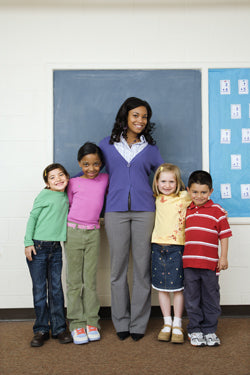Blog Series: Prep Your Library!
With back-to-school around the corner, we are excited to share a series of blogs offering valuable tips and thought-provoking questions about building and organizing school/classroom libraries.
This blog was previously published; we are re-sharing it today as part of our series.
By Susan Bennett-Armistead, author of the informational texts in our My World Series / Colección Mi Mundo.
Selecting Nonfiction with Diversity in Mind
I recently came back from a trip to an African country. While there, I had the opportunity to visit a few shops. I discovered that it was impossible to find a doll with dark skin. All the dolls were white. In a country where the population is 99% black, a child could never find a doll that looked like him. What message does that send about what is valuable and desirable? It got me thinking about how we represent diversity in our own country.

Many of us have designed our classrooms to be more responsive to the variety of diversity represented by the children in our program. The National Association for the Education of Young Children’s accrediting process and individual programs such as Head Start and YMCA’s child care programs insist that diversity be addressed in early education settings. (For this discussion, diversity is broadly defined, including gender, racial, economic, linguistic, educational, body type, ability, family structure, and ethnic diversity.)
For most of us, this translates to actions such as making sure we have baby dolls of more than one race, books that have representations of families that look like our children’s families, and more than one language represented on our classroom posters and labels. When we think about the books in our classroom, we tend to select our story books with diversity in mind, but we must do the same with our informational texts. Here are some tips for examining informational texts and their use with an eye toward diversity:
Select Topics that Appeal to Various Groups
Some topics are part of the universal experience: family, friends, insects, transportation, clothing, etc. Everyone has a relationship with these topics; no one is excluded, even if there is variation by community or region. On the other hand, some subjects, such as holidays, can leave children and their families behind. Choose topics to include rather than exclude while broadening everyone’s experience and content knowledge.
Choose Content-Based Books with an Eye Toward Diversity
Whatever topic you choose to address, you will reinforce it with books throughout your classroom and day. When selecting informational books, look for books depicting people of color, families with non-traditional structures, and people using assistive devices. Include informational texts written in more than one language.
You might wonder how much to do this. In our series, My World / Mi Mundo , we used the ratio of people of color in the US to guide our selection of photos. For example, in the US, approximately twelve percent of the population is African American. In our series, approximately twelve percent of the images show African Americans. If most of your class is one racial group, you might use that as your guide for selecting materials. Beware of representing one group at the expense of another. Even if all your children have the same racial background, family structure, or ability level, there is value in having more than one group depicted.
Supporting Materials Can Represent Diversity
When children have the opportunity to make concepts their own through play, such as dramatic play and art, be sure to include materials from various cultures.
If you are talking about nutrition and setting up a grocery store in the dress-up area, include foods that may come from other places or might not be familiar to all the children in your group. Start with what they know and add more novel material. A great way to do this is to encourage families to contribute materials for your theme. The foods one family eats may differ significantly from another family’s diet. Sharing their empty containers to use in the dress-up area grocery store gives your class an excellent opportunity to talk about foods from different families.
Look For Experts Who Reflect Diversity

If you are studying insects, you may talk about scientists who study insects. Strive to select scientists of more than one race and from different countries, including both genders. Guest speakers who visit you should be held to the same standard. Similarly, authors of books on topics you read ideally represent diversity.
Discussions of Stories Can Turn into Informational Analysis
A good friend of mine teaches a unit on Cinderalla stories each year. She uses the traditional French tale, Mufaro’s Beautiful Daughters, The Rough Faced Girl, and some goofy ones like Cinderella Penguin . Each comes from a different culture with its own clothing, customs, and way of talking. After the children have heard many different Cinderella stories, they analyze what is the same and different about the stories. While the stories themselves are not informational texts, the analysis of the text is similar to how we analyze information about any topic. This works well with older children working independently in small groups and with little children in a whole- or small-group setting with adult support.

~~~

Susan Bennett-Armistead, Ph.D., is an associate professor of literacy education, the Correll Professor of Early Literacy, and the coordinator of literacy doctoral study at the University of Maine. Before her doctoral study, Dr. Bennett-Armistead was a preschool teacher and administrator for 14 years in various settings, including a brief but delightful stint in the Alaskan bush.
~~~
For more information on the My World series by this author, you can visit the series page on our website or click the image below to download an information sheet. You may also view our teacher guide and 48 free activity sheets under My World Collection.






